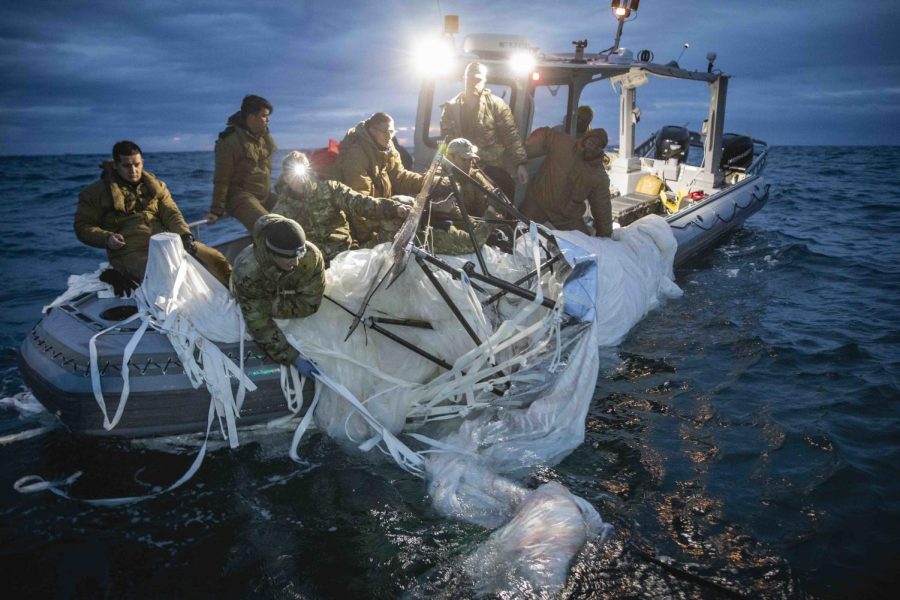The United States shot down a suspected Chinese spy balloon off the South Carolina coast on Feb. 4, claiming that the balloon was spying on US missile sites. China denies these accusations, saying it was a peaceful airship that had simply blown off course.
This incident led to the relationship between China and the US becoming strained, leading some officials to worry about future diplomacy efforts.
On Jan. 27, the United States Defense Intelligence Agency, also known as the DIA, put out an initial report warning that a Chinese balloon was headed for the United States. However, the report did not elicit much of a response from the government. President Biden wasn’t briefed on the situation, and many government officials didn’t see it as an immediate threat.
The next day, on Jan. 28, the balloon officially entered Alaskan airspace. Officials discussed shooting it down, but the decision was ultimately made to leave it in the air. The balloon’s trajectory was expected to dip slightly south, then move up north into Canada. The US government planned to take this opportunity to study the balloon and observe its flight patterns.
However, officials were alarmed when the balloon made a sharp dip south and began steadily moving towards the main 48 states. Despite the severe threat this posed to the nation’s safety, President Biden wasn’t briefed until Jan. 31, at which point he ordered the balloon to be shot down immediately. On this same day, NORAD, a North American aerospace defense agency, issued a report detailing the balloon’s movements, revealing that it was hovering over missile bases and other important military sites.
Between Jan. 31 and Feb. 4, the timeline gets hazy. Not much is known about what exactly happened during this time, leading some to question the Biden Administration’s efficiency.
The balloon was finally shot down on Feb. 4 by a F-22 fighter plane and fell into the Atlantic Ocean off the coast of South Carolina, effectively resolving the threat. However, even with the object shot down, this situation is far from diffused.
Navy divers are partnering with the Coast Guard to recover pieces of the balloon across a search field measuring 22,500 square meters or about 15 by 15 football fields.
Right now, the focus is on recovering all the parts of the balloon floating on the surface of the water. Navy divers are beginning to go deeper underwater, hoping to recover more of the balloon’s technology. Self destructing explosives were found in the initial recovered pieces, but otherwise the balloon appears to have no indicators of hostile intentions.
The recovered pieces are being delivered to the FBI facility in Quantico to be examined. In a recent report, new research revealed that the balloon is believed to be part of a fleet covering 40 countries across five continents. It also had surveillance tracking capabilities, but it’s believed that the balloon didn’t share any new information with the Chinese government.
The Biden Administration has received criticism over the lack of an initial response, especially given the urgent situation. Florida Senator Marco Rubio criticized the administration in a tweet. “Our government knew a Chinese military spy balloon was going to enter the airspace over the continental U.S. at least TWO DAYS BEFORE it happened. Yet they failed to act to stop it,” wrote Rubio.
PV history teacher Joe Youngbauer also has some concerns. “I think that more urgency could have been deployed by America, as the balloon moved from Alaska all the way to the east coast,” said Youngbauer. “Considering the balloon moved across the sparsely populated western U.S., I think a quicker response could have been safely executed.”
Questions are also being asked about why the balloon wasn’t considered a threat while in Alaskan airspace. NORAD commander General Glen VanHerck addressed these concerns in a statement to the press. “It was my assessment that this balloon did not present a physical military threat to North America… And therefore, I could not take immediate action because it was not demonstrating hostile act or hostile intent,” said VanHerck.
Tensions between the United States and China are also steadily rising. China refused a call between US Defense Secretary Lloyd Austin and Chinese National Defense Minister Wei Fenghe following the incident. Additionally, U.S. Secretary of State Antony Blinken has indefinitely postponed his planned diplomatic trip to Beijing, leaving many to wonder about the relationship status between the two nations.
Youngbauer is also concerned about the effect this incident may have had on the already strained relationship between these two countries. “The diplomatic meeting between the two nations signals some sense of willingness to listen to each other and work together on matters of mutual interest… but now after this event tensions between the two nations have ramped back up. I wouldn’t anticipate an American visit to China anytime soon,” said Youngbauer.
Despite the massive political effect this incident has had on the world, spy balloons are not a new surveillance tactic. Upon further investigation, it was revealed that three separate spy balloons flew undetected over the United States during Donald Trump’s presidency. When President Biden entered office, he asked NORAD to increase security measures, leading to this discovery. NORAD has acknowledged this “awareness gap,” and promises they’re sorting it out privately.
The entire situation has led many to lose trust in the Biden Administration due to their lack of response, especially given the urgent situation. Going forward, it’s unclear how the administration will recover the trust of the public.
The emergence of this Chinese spy balloon has upset the political world on a global scale. Although it’s not exactly clear what the future consequences of this event will be, it’s clear that this event has changed the current political landscape as we know it.






